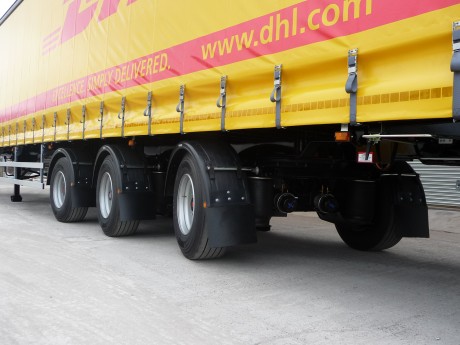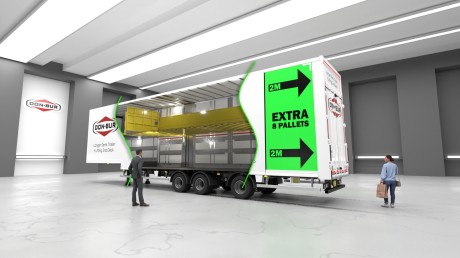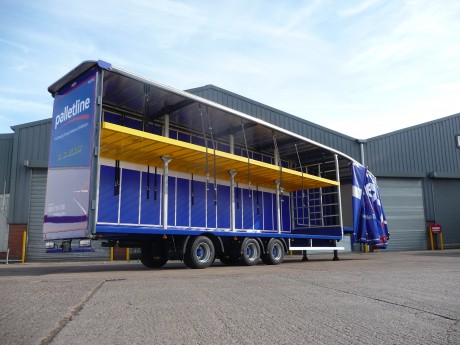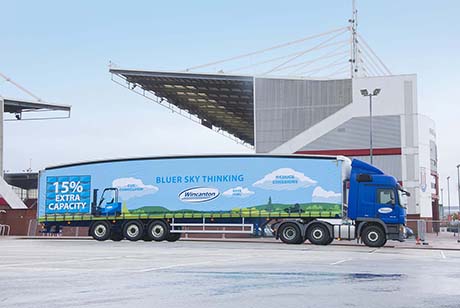Argos has 1,020 trailers in its ‘mainline’ fleet, delivering to each of its 737 stores in the UK and Ireland and moving stock between regional distribution centres. Therein lies the problem. “We’ve got multiple trailer types in the fleet,” explains Dave Parry, head of distribution planning at Argos. He names a myriad of trailer lengths, starting from those as short as 24ft,with 33ft-long tandem-axle trailers particularly numerous.That mix has evolved because many stores, in High Street locations convenient for customers, are not quite so convenient in terms of handling deliveries. Restricted delivery access means many are unable to accommodate the industry standard 45ft trailer. Around 230 stores can accept deliveries only on trailers of 33ft or less.
This is a real disadvantage for a transport operation invariably constrained by cube rather than weight, Parry and his colleagues are always looking for smarter ways of maximising trailer capacity and hence productivity. Argos was an early advocate of double-deck trailers – including 33ft examples - and is now adding 15.65m LST (longer semi-trailers) into the mix as well, for selective use where possible.The company not only wants to maximise capacity but also reduce the variety of trailers.“Our aim is to standardise the fleet as much as possible,” says Parry, reasoning that this makes scheduling more efficient because trailers become more versatile.
A potential solution surfaced March last year when Parry, in his former role as Argos strategic transport improvement manager, was talking to IMS, the Shepshed,Leicestershire-based UK and Ireland distributor of SAF trailer axles. IMS also represents VSE of the Netherlands, a company specialising in advanced steering and suspension systems for truck and trailers. IMS sales manager Ben McEvoy suggested that VSE’s Electronic Trailer Steering (ETS) could allow Argos to run bigger trailers into stores that currently call for 33-footers, out-performing even the most agile in the fleet, fitted with a mechanically actuated positively steered rear axle. “Ben was very confident that ETS would allow a 40ft trailer to get into these locations, but I pushed for 45ft,” says Parry, hungry for extra productivity. The 33ft trailers take 25 roll cages, whereas 45ft trailers can handle 35 cages,boosting capacity by 40%.
IMS has supplied only two other ETS systems so far, one for a milk collection tanker in Ireland,the other for Dick Denby’s clever 25.25m-long Eco-Link B-double outfit, so Argos’s is the first for mainstream use in the UK. “It could be seen as a little bit wacky,” observes Parry, “but it is one of a whole series of initiatives we have to reduce transport costs and cut carbon emissions.”
Working with trailer manufacturer Don-Bur (Bodies and Trailers) VSE engineers calculated the axle positions and the steering responses for the two steered axles on the Argos 45ft-long triaxlecurtainsider. The wheelbase (kingpin to centre axle) is nothing out of the ordinary at 8,050mmbut spacing of the SAF disc-braked axles is 1,810mm, around 500mm more than with a conventional un-steered tri-axle trailer. With axles two and three steered, tyre scrub is virtually eradicated so there is no need to keep the axles closely set. As well as optimising manoeuvrability, this spacing is also good for load distribution, so the trailer is suitable for 44 tonnes GCW if required. The rear axle has a maximum steer angle of 35 degrees; the centre axle’s is 17 degrees. This geometry means that the trailer follows the path prescribed by the rear of the tractive unit very closely indeed. Not only is cut-in dialled-out but there is also very little outswing at the rear of the trailer on sharp turns.
The additional weight of steering two of the trailer’s three axles with ETS is surprisingly modest, at just 400-450kg. Arran Leatherland, IMS sales and marketing manager, points out that this is a tonne less than steering two axles via the usual mechanical linkages and turntables. “But the real point is that traditional systems can’t do the same because they are not intelligent enough, so wouldn’t deliver the operational advantages that Argos is looking for,” adds Leatherland.
There is no avoiding the question of cost. Leatherland says two-axle ETS steering adds £18,000-£20,000 to the price of a typical triaxle trailer, so this level of sophistication is not cheap. Argos’s Parry does not make light of this on-cost but says his projections indicate the extra productivity does recoup it. “When we did the business case we found that the trailer can pay for itself within a couple of years.” That is based purely on savings accrued from carrying more, making fewer trips and cutting kilometres. Argos has not attempted to evaluate the reduction in tyre wear that may be expected as a result of reducing scrub. Additional maintenance is restricted to greasing the steering axles’ kingpins at intervals of up to six months and the occasional hydraulic filter change; VSE hydraulics are self-bleeding.
When CM saw the ETS trailer in action last month it was still running trials to establish exactly what it can do and where it can go. It is working out of the Argos’s regional distribution centre in Bridgewater, Somerset. Run on behalf of Argos by Wincanton, this RDC serves 104 stores in the South West, extending northwards into Worcestershire. Initially, the ETS trailer has been used for stores such as Penzance, Newquay, St Austell and Truro, all normally restricted to 33ft trailers, and where the long stem distance – 400km-500km per round trip – really maximises the operational savings of running a more productive outfit. “It’s been brilliant,” says Parry. “It’s gone in everywhere we wanted it.” Driver response has also been good. “We’ve had no issues at all,” reports Tim Byrne, Wincanton’s contract distribution manager at Bridgwater. “The reactions of all the drivers who have used it so far have been positive.”
After a few weeks of experimentation, Argos now starts its real assessment of the ETS trailer. “We are not due to replace any of the 33ft trailers for another couple of years, so by then we will know enough about it to take the appropriate decision,” says Parry. If the ETS concept proves to be as successful and cost-effective as initial impressions suggest, Parry envisages that it could eventually replace all 33ft trailers in the Argos fleet, becoming a truly versatile animal. “We may look to construct a business case that looks at whether we could pull that capital spend forward a year or two,” he ponders.“If we buy 100 of these instead of 160 33-footers and we save trips and kilometres every day, the savings add up and the trailers pay for themselves surprisingly quickly, but there has to be a really strong business case behind it to release that capital” he concludes.
The secret of agile trailers: how ETS works
VSE’s Electronic Trailer Steering (ETS) system differs from the more common type of positive steer system for trailers in two key respects. First, the axle beams are fixed, rather than mounted on swivelling turntables. Instead, the wheels are carried on stub axles and steered according to the Ackerman principle, with the inner wheels steering a tighter radius than the outer wheels when turning a corner. Second, the axles’ steering input, determined by trailer’s articulation angle with the tractor unit, is evaluated and transmitted electronically rather than by means of a mechanical (rod or cable) or hydraulic linkage.
Unlike turntable systems, only the wheels rather than the complete axle are steered, so axle spacing and position is determined purely by steering geometry and load distribution rather than the need to leave sufficient space for axle articulation. And the use of electronic control rather than a physical linkage allows greater sophistication, notably speed-dependantsteeringangles tailored individually for each axle.Larger wheel angles are used during slow-speed manoeuvring, gradually reducing as speed exceeds 25km/h. Once speed exceeds 55km/h the wheels automatically arelocked in the dead-ahead position for straight-line running.
ETS determines the tractor-trailer articulation angle by means of a contactless magnetic angle sensor integrated within the trailer’s kingpin.A free-swinging ‘reaction arm’on the kingpin mates with the fifth-wheel’s jaws, transferring the tractor-trailer articulation angle to the kingpin sensor. A change in the angle varies the voltage in the circuit, and this is converted into an angle value by the system’s electronic control unit (ECU). At the same time, similar sensors on the trailer axles detect the wheel angles. Armed with this information, plus vehicle speed data, the ECU’s processor references a table of pre-programmed steering responses contained within the software. This is written by VSE to suit each individual trailer’s geometry and required turning circles.
The ECU’s electrical output is converted to a steering response at the trailer’s wheels by solenoids that control the oil flow from ETS’s hydraulic system. Thisactuates the steering cylinders parallel to each of the two steered axles. The necessary hydraulic pressure is generated by an electro-hydraulic power-pack, housed in a locker mounted on the side of the trailer chassis.The system is powered by a pair of batteries on the trailer, recharged via an additional electrical connector between tractor and trailer. This extra electrical connector is the only adaptation required on the tractor unit, so once that is provided, the trailer is compatible with any unit in the fleet.
Each steering axle also has a ‘centring’ hydraulic cylinder, plumbed in a separate circuit, locking the wheels in the straight-ahead position. VSE says both systems have a fail-safe mode that disables the steering so that the trailer would behave like a conventional one in the event of hydraulic failure.
VSE engineers in the Netherlands initially configured the ETS software on the trailer to suit the turning and manoeuvring requirements stipulated by Argos. Should it prove necessary, they can adjust the trailer’s agility by modifying the software and emailing the file to Argos for uploading via a laptop to the trailer’s ECU.
A hand-held wireless remote control can be used to change the steering angles without moving the vehicle, just like the ones used by abnormal load outfits that have to be inched around street furniture. IMS’s Leatherland dubs this a ‘get out of jail’ card, avoiding difficult shunting in really tight situations. Argos so far has not found the need to take this remote control option.
We’d love to hear from you – get in touch today!

.jpg)



